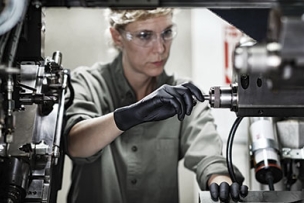Can nitrile gloves be recycled?
With more businesses shining a light on their sustainability efforts, finding a way to keep waste out of landfills has taken on a new level of importance. Programs like RightCycle by Kimberly-Clark Professional® help companies keep used personal protection equipment (PPE), including nitrile gloves, out of landfills.
What’s the difference between latex and nitrile gloves?
Latex is one of the most recognizable material types, but allergies to latex proteins are common. Nitrile gloves are made of a nonallergenic, synthetic byproduct of oil and latex, making them a popular alternative for glove wearers with latex allergies.
Since latex gloves revert to their original shape when removed, it can be nearly impossible to spot pin-size holes. “[But] with nitrile gloves, you will see a tear in the glove,” McLean explains. “It is designed so that you can see where you are at risk of being contaminated.”
FDA requirements for gloves?
According to McLean, gloves must meet Food and Drug Administration (FDA) requirements before being sold. For instance, a glove needs to meet the FDA's minimum requirements for pinholes (AQL 2.5), the minimum pinhole level to be considered a medical glove. In addition, medical exam gloves are subject to a battery of other rigorous trials before being deemed medical-grade and sold with the word “exam” on the box.
Professionals who work in foodservice or food processing must also be sure their gloves meet FDA requirements for food handling.
Does disposable glove color matter?
In terms of effectiveness, there’s very little difference. However, some environments have specific color preferences.
Cleanrooms
In cleanrooms and other controlled environments, the glove color of choice is typically white, making it easier to see contaminants. However, color is also a glove additive, which may have reactions to cleanroom products and processes.
Labs
It’s common for labs to require different colored gloves to differentiate between other lab areas to help reduce cross-contamination.
Previously Featured on Kimberly-Clark's Workplace Insights.
Browse Kimberly-Clark's line of disposable and single use gloves on MSCDirect.com.








Talk to Us!
Leave a reply
Your email address will not be published. Required fields are marked *